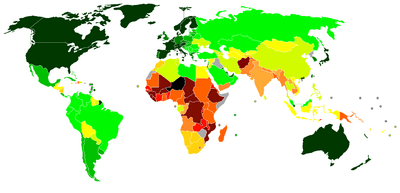Economic development facts for kids
Economic development is the growth of the standard of living of a nations people from a low-income (poor) economy to a high-income (rich) economy. When the local quality of life is improved, there is more economic development.
When social scientists study economic development, they look at a lot of things. They want to know about the way economic development is discussed by historians. They also want to know how development is happening today. They may want to know why people invest more money in some places than in others. They also want to know why people are better at making things to sell in some countries rather than others.
Measuring Economic Development
|
0.950 and Over 0.900–0.949 0.850–0.899 0.800–0.849 0.750–0.799 |
0.700–0.749 0.650–0.699 0.600–0.649 0.550–0.599 0.500–0.549 |
0.450–0.499 0.400–0.449 0.350–0.399 under 0.350 not available |
Same map for people with color blindness.
One way to measure economic development is human development. Human development is very important, and includes the health of the people and their education. This usually goes together with economic growth. As people in a country become healthier and get better education, they also usually get richer, because healthy, educated workers are more productive (better at making things), and richer workers can afford health and education. The Human Development Index looks at how long people live, how well people read, how many people go to school, and how much money people make.
Economists also look at the rate of growth, which is how fast a country gets richer.

Related pages
- Developed country
- Developing country
- Development economics
- Human Development Index
- Newly industrialized country
- Least developed country
- OECD
- BRICS
- Next Eleven
- Four Asian Tigers
See also
 In Spanish: Desarrollo económico para niños
In Spanish: Desarrollo económico para niños


